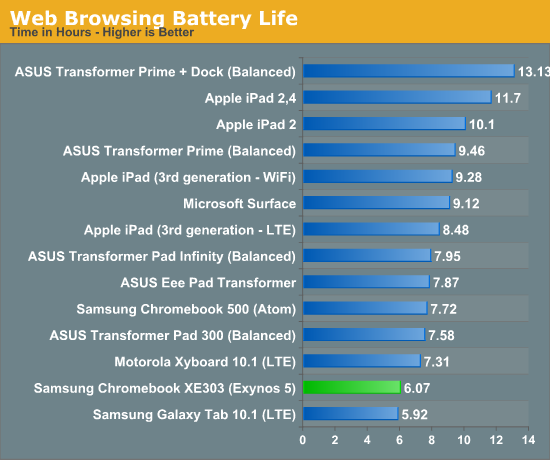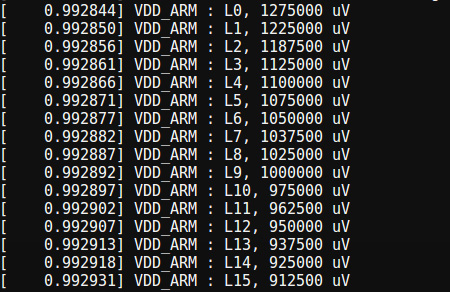Samsung Chromebook (XE303) Review: Testing ARM's Cortex A15
by Anand Lal Shimpi on October 31, 2012 9:00 AM ESTBattery Life & Power Analysis
The final unknown in all of this is power consumption. ARM's Cortex A15 isn't really supposed to be a sipper of power, and when placed in a notebook I don't know that there's a lot we can conclude about how it stacks up to Atom either. Some high level power consumption data would normally help but these two platforms are fairly different:
| Samsung Chromebook Power Consumption Comparison | ||||||
| Display @ 200 nits | Idle | Kraken (Avg) | Kraken (Peak) | |||
| Samsung Chromebook 500 (Atom N570) | 11.53W | 14.4W | 15.2W | |||
| Samsung Chromebook 303 (Exynos 5 Dual) | 6.33W | 10.5W | 11.3W | |||
The new Chromebook consumes considerably less power at idle than its predecessor. The smaller display, simplified motherboard and truly integrated SoC platform are likely all to thank for this. The significant reduction in power also helps explain the big reduction in battery capacity as well.
Under load, the two platforms do see differing levels of additional power consumption. The new Exynos 5 based Chromebook sees a dramatic increase in power consumption under load, hitting 10.5W (a 66% increase over idle) while running Mozilla's Kraken benchmark. The Atom N570 based Chromebook increases power consumption as well, but just not by as significant a degree: ~25%. This actually helps illustrate exactly why Atom wasn't phone worthy in its earlier incarnations. Contrary to popular belief, it wasn't actually peak power consumption that was the problem (a move to 32nm can easily eat into these numbers). The total platform power consumption, particularly at idle, was Atom's real problem in the early days. It also turns out that this is much of what keeps Intel's Core processors from moving into ultra mobile form factors, something that Haswell is supposed to address.
Given that we're dealing with somewhat different panels here, I wanted to see what power consumption looked like if we removed the panels from the equations. I re-ran all of the power data with the display turned off:
| Samsung Chromebook Power Consumption Comparison | ||||||
| Display Off | Idle | Kraken (Avg) | Kraken (Peak) | |||
| Samsung Chromebook 500 (Atom N570) | 8.82W | 11.4W | 12.4W | |||
| Samsung Chromebook 303 (Exynos 5 Dual) | 4.07W | 8.32W | 9.27W | |||
The old Atom based Chromebook uses more than twice the idle power of the new version - it's no wonder Google was able to get away with a battery half the size. Once again however we see a much larger increase in power consumption once the Cortex A15 is under heavy load. Active power consumption more than doubles on the new Chromebook, while we see around a 30% increase on the Atom based system. I do wonder what will have to be done to get the Exynos 5 Dual into a smartphone as an increase of ~4W under load just won't cut it in a phone. The Atom platform shows a 2.6W increase in power under load, which sounds about right for a high clocked 45nm part.

Despite the more power efficient platform, the reduction in battery capacity puts the new Chromebook well below the Atom model in battery life. Our wireless web browsing test put the new Chromebook at just over 6 hours of continuous use on a single charge. For a notebook that's not too bad, but compared to modern tablets it's not good.

The performance gains over Atom (and by extension, the ARM Cortex A9) do give us some indication as to what could be done to get Exynos 5 into a smartphone. By dropping clocks much lower than 1.7GHz Samsung would be able to maintain a performance advantage in a very power constrained device and hopefully keep power in check. The photo above features a list of all of the voltage levels supported by Samsung's Exynos 5 Dual as implemented in the new Chromebook.










149 Comments
View All Comments
MadMan007 - Wednesday, October 31, 2012 - link
It is a valid comparison, however there is an unanswered question: What do I get for stepping up to the Celeron Chromebook? And that is a valid question, even though at that price point there are more options.Selden - Wednesday, October 31, 2012 - link
By stepping up to the Samsung 550, you get a larger and brighter (300 nits vs 200 nits) screen (but lower resolution, 1280x800), 4 GB of RAM, slightly better faster CPU performance, longer battery life (much bigger battery), and a card reader slot that doesn't let the card stick out (approx. 1 cm) from the case. For performance, the 4 GB of RAM is probably the most significant factor, as it lets you open many more tabs.jeffkro - Wednesday, October 31, 2012 - link
You also get the ability to play netflix content.LogOver - Thursday, November 1, 2012 - link
Some benchmarks shows 50-80% better performance for 1.3Ghz Celeron-based chromebook.http://gigaom.com/mobile/intel-v-arm-the-chromeboo...
I would like to see confirmation from Anand. Also some GPU benchmarks (Celeron vs. Exynos) would be welcomed.
krumme - Friday, November 2, 2012 - link
And that just proves celeron is no competitor for A15 as the performance difference means nothing compared to the total cost differences for the intended segment.An more interesting comparison would even be to the old AMD APU bobcat, in some low voltage variants.
But ofcourse its the new lowcost AMD/Intel variants that is going to be the main competitors.
LogOver - Friday, November 2, 2012 - link
Samsung asks ~$450 for Celeron Chromebook, but this doesn't mean that Celeron-based netbooks have to be expensive. You can buy Acer AO756 for just $265 from bestbuy (and it inclides$100 Win Home Premium and 320Gb HDD which chromebook lacks)http://www.bestbuy.com/site/searchpage.jsp?_dyncha...
And if you wish, you can install Chrome OS on it by yourself.
AgeOfPanic - Wednesday, October 31, 2012 - link
Anand, could you tell us how it compares to the Atom in day to day use? I currently own a Samsung Series 5 chromebook and I would like to know if it makes any sense to upgrade to this model. Seems I would have to take a hit in battery life, but I heard you can at least watch 720p Youtube videos on it.Krysto - Thursday, November 1, 2012 - link
You can watch 1080p videos on it if you want. It has a vastly better GPU. Maybe you can sell yours, and pay little to no difference to get this new one. The performance improvement overall should be noticeable.AgeOfPanic - Thursday, November 1, 2012 - link
Anand doesn't seem to be too convinced. Performance in normal browsing seems acceptable. Don't really understand, because Chrome on a tablet is plenty fast.krumme - Wednesday, October 31, 2012 - link
It looks like ARM 15 is making it very difficult for Intel and AMD for this low cost market. Especially with win8 machines comming.I dont know how Intel can catch up to this competition with the new Atom. When 22nm Atom hits market, TSMC is printing dirt cheap A15 on 28nm for everyone and his brother; tablets, phones, notebooks. Heck even some server segments is going Arm. And the performance looks like its sufficient for grandma.
The new Atom and new bobcat better have some tangible performance benefits both on cpu and gpu side - they simply need to drive most if not all, pc games well on a notebook.
I am impressed by the performance of ARM here.